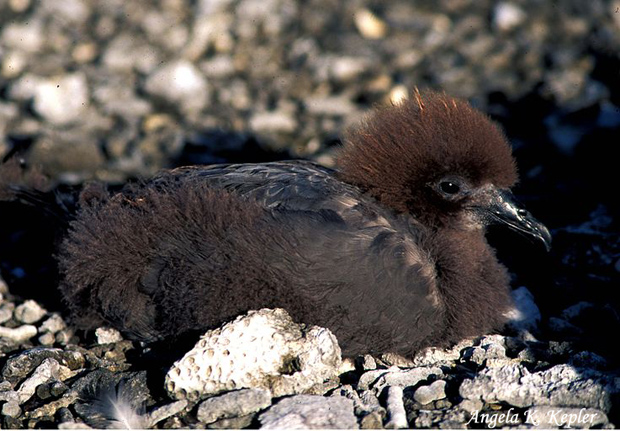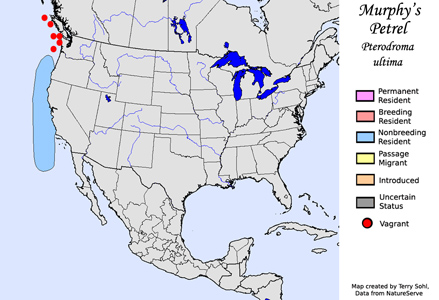| Length: 15 inches | Wingspan: 34 inches | Seasonality: Non-resident in South Dakota |
| ID Keys: Dark plumage above and below, stubby dark bill, paler "chin" area, dark "M" pattern on upper wings seen in good light | ||
 The
Murphy's Petrel is relatively "new" to science, having only first been
described as a species in 1949. They breed on a few low-lying islands
in the south Pacific, where their breeding success has plummeted in the last
several decades as the introduction of rats and other invasive species had
led to direct predation of eggs and young birds. Murphy's Petrels were
unknown to approach North America until pelagic birding tours far off the
west coast of the United States started occasionally finding them in the
spring. The photo to the right shows a young fledgling. Adult
birds are known for their dark overall plumage, an "M" shaped dark marking
across their upper wings (visible in flight), and a stubby dark bill.
The
Murphy's Petrel is relatively "new" to science, having only first been
described as a species in 1949. They breed on a few low-lying islands
in the south Pacific, where their breeding success has plummeted in the last
several decades as the introduction of rats and other invasive species had
led to direct predation of eggs and young birds. Murphy's Petrels were
unknown to approach North America until pelagic birding tours far off the
west coast of the United States started occasionally finding them in the
spring. The photo to the right shows a young fledgling. Adult
birds are known for their dark overall plumage, an "M" shaped dark marking
across their upper wings (visible in flight), and a stubby dark bill.
Habitat: Breeds on small rocky islands in the south Pacific. Pelagic at other seasons, typically on the open ocean very far from land.
Diet: Feeds on fish, squid, small crustaceans, and other small marine creatures.
Behavior: Mostly feeds by flying over the water's surface, dipping down and skimming prey from the surface or just below the surface while maintaining flight.
Nesting: The nest of a Murphy's Petrel is a shallow scrape, often at the base of a small tree or rock, or sometimes in a cavity on a cliff or rocky area. They lay a single egg that is incubated by both the male and female. After the egg hatches, both parents tend to the young and help feed it.
Song: Usually silent at sea away from breeding colonies. On breeding colonies, has multiple hooting and crying calls.
Migration: Breeds in a small number of island locatiosn in the south Pacific. Non-breeding birds disperse widely in the Pacific basin, with breeding areas completely abandoned outside of the breeding season. Non-breeding birds are found as far north as the Hawaiian Islands, and as far east as off the west coast of the United States.
Interactive eBird Map: Click here to access an interactive eBird map of Murphy's Petrel sightings
Similar Species: In the North American portion of their range, possibly confused with other dark bodied Petrel and Shearwater species. The overall dark plumage, both on the bird's upperparts and underparts, coupled with the very short stubby bill, help to differentiate the species.
Conservation Status: Breeding locations have been disturbed by anthropogenic activity in the past which has greatly reduced breeding populations. The introduction of rats to nesting islands has decimated some breeding populations, while development and human use of other islands has similarly reduced breeding success. Populations continue to decrease, and the IUCN lists the Murphy's Petrel as "Near Threatened".
Further Information: 1) BirdLife International - Murphy's Petrel
2) ARKive.org - Murphy's Petrel
3) Audubon's Guide - Murphy's Petrel
Photo Information: Photo of fledgling Murphy's Petrel taken by Angela Kepler on Oeno Island - Released into the Public Domain.
| Click below for a higher-resolution map |
 |
| South Dakota Status: Non-resident in South Dakota |
Additional Murphy's Petrel Photos (Coming soon!)
